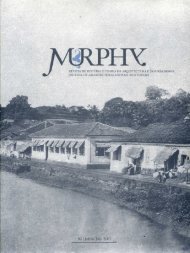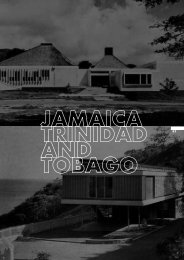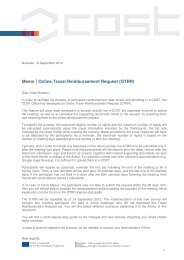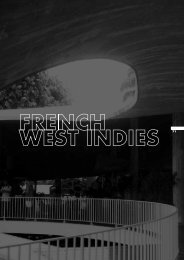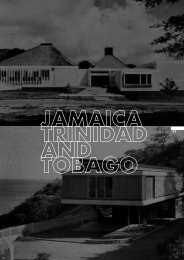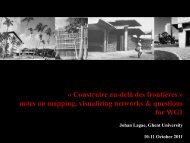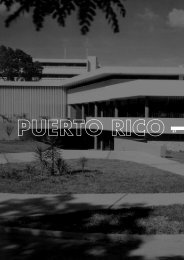Martinique, Case studies in modernism
Martinique, Case studies in modernism
Martinique, Case studies in modernism
You also want an ePaper? Increase the reach of your titles
YUMPU automatically turns print PDFs into web optimized ePapers that Google loves.
apartments, <strong>in</strong> Cluny, a neighborhood of Fort-de-France,<br />
as well as the Résidence des Palmiers (1960) (fig. 10).<br />
THE CONSTRUCTION of grands ensembles (large social<br />
hous<strong>in</strong>g developments) that marked the construction<br />
policies of the 1960s, occurred <strong>in</strong> <strong>Mart<strong>in</strong>ique</strong> at the<br />
same time as <strong>in</strong> cont<strong>in</strong>ental France. The follow<strong>in</strong>g are<br />
worth mention<strong>in</strong>g: the Floréal development (Fort-de-<br />
France) <strong>in</strong> 1963, follow<strong>in</strong>g a block plan by Georges<br />
Candilis (1913–1995), 12 Dillon (Fort-de-France) <strong>in</strong> 1965,<br />
follow<strong>in</strong>g a plan by Anto<strong>in</strong>e de Roux (head of the<br />
Antilles Guyana Town Plann<strong>in</strong>g Agency) and Batelière<br />
(Schœlcher) <strong>in</strong> 1969 on a block plan by Maurice de<br />
Lavigne Sa<strong>in</strong>te-Suzanne.<br />
RELIGIOUS ARCHITECTURE<br />
Religious architecture is present and spreads out<br />
throughout the period, from the Église du Prêcheur <strong>in</strong><br />
1930 to the Bethléem Chapel <strong>in</strong> 1960. Are noteworthy:<br />
the Sa<strong>in</strong>te-Thérèse Church (Fort-de-France, 1938),<br />
Josseaud Church (Remy, 1952), the Sa<strong>in</strong>t-Christophe<br />
Church <strong>in</strong> Dillon (Fort-de-France, 1955) by architects<br />
Tessier and Crevaux (fig. 11), the Bethléem Chapel (Fortde-France,<br />
1960). The two latter are the most radical, and<br />
Sa<strong>in</strong>t-Christophe truly belongs to its time, with its curves, its<br />
vault, its concrete lateral ventilation that <strong>in</strong>corporates<br />
colored glass piers, and f<strong>in</strong>ally its apse, a vaulted tower<br />
that plays with light <strong>in</strong> a Le Corbusier-like spirit.<br />
76<br />
© photo Jean Doucet<br />
Fig. 10. Lavigne, résidence Les Palmiers, 1960<br />
A NEW FORMAL VOCABULARY,<br />
AND CONSTRUCTION ASPECTS<br />
Dur<strong>in</strong>g the 1930s, the bulk of rural dwell<strong>in</strong>gs is built<br />
with plant materials: sugar cane straw roofs, and woven<br />
ti-baume 13 walls, and traditional hous<strong>in</strong>g is usually the<br />
rule, as <strong>in</strong> cont<strong>in</strong>ental France.<br />
Us<strong>in</strong>g concrete and re<strong>in</strong>forced cement allowed all sorts of<br />
climatic adjustments that also prompted aesthetic<br />
researches. Covered galleries, cantilevered horizontal<br />
brise-soleils, vertical brise-soleils of varied profiles, screen<br />
walls, have become common (fig. 12). Incl<strong>in</strong>ed posts and<br />
cruciform pillars renew the load bear<strong>in</strong>g element.<br />
Sometimes there are unexpected additions, such as a<br />
concrete covered gallery <strong>in</strong> front of a traditional cab<strong>in</strong>.<br />
Flat roofs are made with filler blocks until the 1960s when<br />
the concrete slab becomes a common deed. Us<strong>in</strong>g it<br />
Fig. 11. Tessier and Crevaux, Sa<strong>in</strong>t-Christophe church, 1955<br />
© photo Jean Doucet<br />
Docomomo N°33<br />
September 2005



